Borneo (2001)
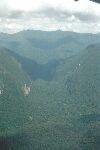 Borneo, the world's third largest island is located to the east of peninsular Malaysia, south of the Philipines and north of Indonesia. It comprises the Malaysian states of Sabah and Sarawak, the small country of Brunei and the Indonesian controlled Kalimantan. Borneo, the world's third largest island is located to the east of peninsular Malaysia, south of the Philipines and north of Indonesia. It comprises the Malaysian states of Sabah and Sarawak, the small country of Brunei and the Indonesian controlled Kalimantan.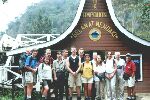
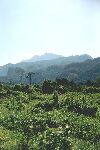 Flying from Heathrow, London via Kuala Lumpur we eventually landed in Kota Kinabalu, the capital of Sabah near the northwest corner of Borneo. At the airport we were met by Addy, our tour leader, a native of Sarawak and a smiling and friendly man. After a night in our comfortable hotel we met up with the rest of our touring group, which consisted of 3 honeymoon couples; myself and Clare, Rachel and Nick and Catherine and Giles, an intrepid solo traveller; Andy and 4 other couples; Kim and Mark, Helen and John, Steve and Lynda and Allan and Felicity and of course, our ever-smiling Addy. Flying from Heathrow, London via Kuala Lumpur we eventually landed in Kota Kinabalu, the capital of Sabah near the northwest corner of Borneo. At the airport we were met by Addy, our tour leader, a native of Sarawak and a smiling and friendly man. After a night in our comfortable hotel we met up with the rest of our touring group, which consisted of 3 honeymoon couples; myself and Clare, Rachel and Nick and Catherine and Giles, an intrepid solo traveller; Andy and 4 other couples; Kim and Mark, Helen and John, Steve and Lynda and Allan and Felicity and of course, our ever-smiling Addy.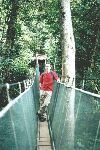

Next day we headed off on our adventures travelling east towards Kinabalu National Park but stopping first at Poring Hot Springs, or Boring Hot Springs morelike.
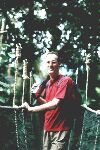 What was interesting though was a walk on a suspended boardwalk at around 30ft. above the Rainforest floor, very Indiana Jones, by the way if you ever do go on one ignore your guide's advise and do bring your video camera, you have to pay and exorbitant fee RM30, which is around IR£7 but how many times are you going to be able to walk through the Rainforest canopy? Retiring to our Guesthouse we contemplated our forthcoming ascent of Mount Kinabalu, which at 4,095m is South East Asia's highest peak. What was interesting though was a walk on a suspended boardwalk at around 30ft. above the Rainforest floor, very Indiana Jones, by the way if you ever do go on one ignore your guide's advise and do bring your video camera, you have to pay and exorbitant fee RM30, which is around IR£7 but how many times are you going to be able to walk through the Rainforest canopy? Retiring to our Guesthouse we contemplated our forthcoming ascent of Mount Kinabalu, which at 4,095m is South East Asia's highest peak.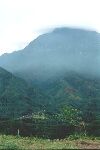
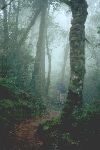 The start of the mountain trek is already at an altitude of around 1,800m but there is no room for complacency as the going is steadily up and noticibly steep. We were warned beforehand that this part of our holiday should be undertaken only by those of reasonable fitness and that was fitting advice. The climb to the summit of Mount Kinabalu is one of the highest amateur climbs in the world, and those unprepared realise this early on. Fortunately
climbers can travel at their own pace and no-one is rushed. It took us some 5 hours to reach our camp for the night which is at around 3,400m. The start of the mountain trek is already at an altitude of around 1,800m but there is no room for complacency as the going is steadily up and noticibly steep. We were warned beforehand that this part of our holiday should be undertaken only by those of reasonable fitness and that was fitting advice. The climb to the summit of Mount Kinabalu is one of the highest amateur climbs in the world, and those unprepared realise this early on. Fortunately
climbers can travel at their own pace and no-one is rushed. It took us some 5 hours to reach our camp for the night which is at around 3,400m. 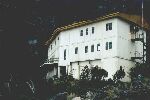 We slept in a large mountain chalet in a room with five bunk beds housing five couples, the electric heater was left on all the time, the temperature up this high even in a tropical country such as Borneo compares to the west coast of Ireland towards the end of the year, in other words mighty winds and almost freezing temperatures. We slept in a large mountain chalet in a room with five bunk beds housing five couples, the electric heater was left on all the time, the temperature up this high even in a tropical country such as Borneo compares to the west coast of Ireland towards the end of the year, in other words mighty winds and almost freezing temperatures.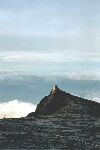
 We had gone to bed that night at around 9pm and no-one slept much, the anticipation of what was to come kept most awake. We didn't have to wait long, however as we were called to readiness at 2am by the always smiling Addy, wrapped in a blanket. Obviously at this time of the night/morning it's pitch dark, very windy and extremely cold. I had dismissed the warning to pack gloves thinking 'Gloves, in Borneo!', I was the only one without them and suffered accordingly. We had gone to bed that night at around 9pm and no-one slept much, the anticipation of what was to come kept most awake. We didn't have to wait long, however as we were called to readiness at 2am by the always smiling Addy, wrapped in a blanket. Obviously at this time of the night/morning it's pitch dark, very windy and extremely cold. I had dismissed the warning to pack gloves thinking 'Gloves, in Borneo!', I was the only one without them and suffered accordingly.
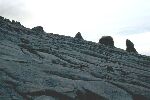 After forcing down some food, very alien at that time of night, we heard from our mountain guides that the ok had been given to climb, they don't allow climbing to the summit if the weather is too bad. At 3am we started off, in single file, in the dark, with our little torches and the wind howling at us to get back to bed. After forcing down some food, very alien at that time of night, we heard from our mountain guides that the ok had been given to climb, they don't allow climbing to the summit if the weather is too bad. At 3am we started off, in single file, in the dark, with our little torches and the wind howling at us to get back to bed.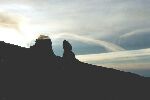
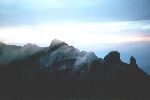 Some of the more fit members of our group quickly disappeared led by one of the vigilant mountain guides, the second guide stayed at the end of our group so as make sure no-one was in trouble. Initially our pace was ok, just more of the steep steps cut into the ground or incorporated into tree roots as it had been on the initial climb to the guesthouse but after a time the vegetation thins out until quite suddenly all that's ahead of you is exposed granite rockface. Here and there ropes anchored to the rockface provide a handhold where you literally haul yourself up the mountain. Some of the more fit members of our group quickly disappeared led by one of the vigilant mountain guides, the second guide stayed at the end of our group so as make sure no-one was in trouble. Initially our pace was ok, just more of the steep steps cut into the ground or incorporated into tree roots as it had been on the initial climb to the guesthouse but after a time the vegetation thins out until quite suddenly all that's ahead of you is exposed granite rockface. Here and there ropes anchored to the rockface provide a handhold where you literally haul yourself up the mountain.
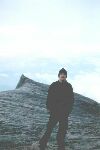 Clare suffered some with altitude sickness feeling very weak and having to stop many times to catch her breath and give her head time to adjust to the different level of oxygen. Clare suffered some with altitude sickness feeling very weak and having to stop many times to catch her breath and give her head time to adjust to the different level of oxygen.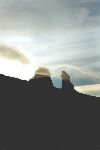 She also wanted to give up and return to the guesthouse several times but after a rest and encouragement continued for 'another few metres'. When I say 'rest' I only mean that we stayed in one place while some time passed, there is no shelter whatsoever on the rockface and the wind is relentless and cutting. She also wanted to give up and return to the guesthouse several times but after a rest and encouragement continued for 'another few metres'. When I say 'rest' I only mean that we stayed in one place while some time passed, there is no shelter whatsoever on the rockface and the wind is relentless and cutting. 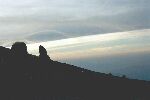 You also have no view of where you are going, you just see ridge upon ridge to be conquered but you never see the summit until you are nearly there. The reason that the final climb is made in the dark is so that you reach the summit in time for the sunrise, at around 6am. You also have no view of where you are going, you just see ridge upon ridge to be conquered but you never see the summit until you are nearly there. The reason that the final climb is made in the dark is so that you reach the summit in time for the sunrise, at around 6am. Once the sun comes up the clouds descend on the mountain-top and you can no longer see more than a few metres ahead of you. We reached the summit at 5:45am and sat stunned and shivering in the meagre shelter of some giant boulders. My hands were almost immobile from the cold and although Clare had wanted to quit we both agreed that it had been worth it. With the sunrise came amazing views of the surrounding countryside and the barren rock stretching away before us like the very edge of the world. Once the sun comes up the clouds descend on the mountain-top and you can no longer see more than a few metres ahead of you. We reached the summit at 5:45am and sat stunned and shivering in the meagre shelter of some giant boulders. My hands were almost immobile from the cold and although Clare had wanted to quit we both agreed that it had been worth it. With the sunrise came amazing views of the surrounding countryside and the barren rock stretching away before us like the very edge of the world.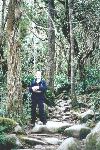
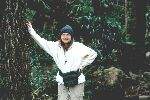 The sense of achievement was considerable as we made our way back down to the guesthouse and breakfast. The way down was much easier except on the knees which took a jolt with every step. As we were walking down the clouds descended, almost chasing us off the mountain-top. It felt like it was raining sideways and by the time we got back to the guesthouse the back of my jacket and trousers were soaked. The sense of achievement was considerable as we made our way back down to the guesthouse and breakfast. The way down was much easier except on the knees which took a jolt with every step. As we were walking down the clouds descended, almost chasing us off the mountain-top. It felt like it was raining sideways and by the time we got back to the guesthouse the back of my jacket and trousers were soaked.
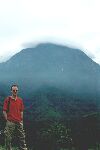 Although the ascent had been over two days the descent was in one as after breakfast we braved the now enveloping cloud and headed back down arriving back to the park headquarters around 4 hours later. During the whole mountain experience Clare had been feeling but putting off some tummy-trouble but after we had been bussed back to our guesthouse she crashed out and stayed poorly for two days. Although the ascent had been over two days the descent was in one as after breakfast we braved the now enveloping cloud and headed back down arriving back to the park headquarters around 4 hours later. During the whole mountain experience Clare had been feeling but putting off some tummy-trouble but after we had been bussed back to our guesthouse she crashed out and stayed poorly for two days.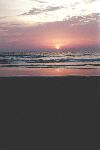 On a much sadder note the morning we made our way back down the mountain, Wednesday we passed an English family going up. It was only days later that we heard that after ascending to the summit on the Thursday morning the 17 yead old daughter, Ellie James had strayed away from her group with her 15 year old brother and gotten lost. The brother was found later that evening on his own and a huge search was continued over the next six days to no avail until eventually the girl's body was found a mere 500m from where she had been last seen. There had been some unusually bad weather around that time which hampered rescue efforts and proven that the mountain trek very occasionally takes a deadly toll. On a much sadder note the morning we made our way back down the mountain, Wednesday we passed an English family going up. It was only days later that we heard that after ascending to the summit on the Thursday morning the 17 yead old daughter, Ellie James had strayed away from her group with her 15 year old brother and gotten lost. The brother was found later that evening on his own and a huge search was continued over the next six days to no avail until eventually the girl's body was found a mere 500m from where she had been last seen. There had been some unusually bad weather around that time which hampered rescue efforts and proven that the mountain trek very occasionally takes a deadly toll.
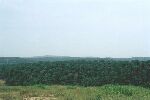 Next morning we travelled east through huge plantations growing palm oil trees to the predominantly Chinese port of Sandakan where in the afternoon while Clare continued her recuperation myself and some of the others had a wander around the town. The fish market was an eye opener. We get so used, in this part of the world to the sanitized way in which our meat is presented and a visit to this market showed the reality is much more bloody and malodorous. That night Addy took us to a seafood restaurant where you could choose your meal by checking out the live fish, lobster, eels and so on swimming in tanks below the boardwalk. I had the veggie selection that night and mostly for the rest of the holiday. Next morning we travelled east through huge plantations growing palm oil trees to the predominantly Chinese port of Sandakan where in the afternoon while Clare continued her recuperation myself and some of the others had a wander around the town. The fish market was an eye opener. We get so used, in this part of the world to the sanitized way in which our meat is presented and a visit to this market showed the reality is much more bloody and malodorous. That night Addy took us to a seafood restaurant where you could choose your meal by checking out the live fish, lobster, eels and so on swimming in tanks below the boardwalk. I had the veggie selection that night and mostly for the rest of the holiday.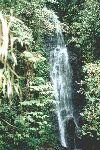
We travelled by boat next morning to Selingan Island known locally as Turtle Island. Here we got to see a giant turtle laying her eggs and then got to watch hatchlings being released into the sea. Of the hundreds released each night it's sad to think that only around 3% survive.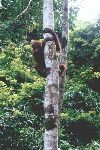
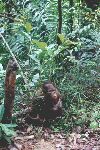 Returning to Sandakan, we continued on to Sepilok Orang Utan Rehabilitation Centre which is the largest of it's kind in the world. The two visits to the feeding platforms where the Great Apes were outnumbered many times by the Great Tourists paled in comparison to our meeting, whilst travelling back to the exit, with a solo Orang Utan who was just out for a ramble in the forest. Returning to Sandakan, we continued on to Sepilok Orang Utan Rehabilitation Centre which is the largest of it's kind in the world. The two visits to the feeding platforms where the Great Apes were outnumbered many times by the Great Tourists paled in comparison to our meeting, whilst travelling back to the exit, with a solo Orang Utan who was just out for a ramble in the forest.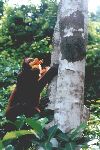 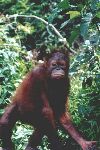 While 'never touching' we got up close to this gangly and wistful-looking ape and were very pleased that we had the opportunity to see it in it's natural habitat and not in Dublin Zoo behind bars. While 'never touching' we got up close to this gangly and wistful-looking ape and were very pleased that we had the opportunity to see it in it's natural habitat and not in Dublin Zoo behind bars.
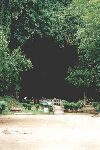 On our journey to Sukau we stopped off at Gomantang Caves, home to one million swiftlets and many thousands of bats.
The nests of these swiftlets, made from a combination of saliva and feathers are harvested at certain times and sold to provide the delicacy of bird's nest soup, yum! Workers scale heights of up to 300ft on fragile ratan and bamboo ladders to reach the nests on the cave ceiling. On our journey to Sukau we stopped off at Gomantang Caves, home to one million swiftlets and many thousands of bats.
The nests of these swiftlets, made from a combination of saliva and feathers are harvested at certain times and sold to provide the delicacy of bird's nest soup, yum! Workers scale heights of up to 300ft on fragile ratan and bamboo ladders to reach the nests on the cave ceiling.
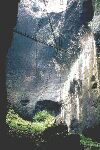 The cave is also home to millions of cockroaches and other insects who live on the enormous pile of guano (droppings) on the cave floor. Fortunately a raised boardwalk makes the walk around the cave relatively bug-free, however there's no escaping the smell!! The cave is also home to millions of cockroaches and other insects who live on the enormous pile of guano (droppings) on the cave floor. Fortunately a raised boardwalk makes the walk around the cave relatively bug-free, however there's no escaping the smell!!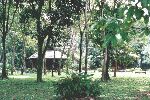
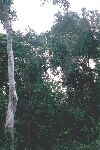 We then travelled on to the Proboscis Resort where in the afternoon we took a river cruise along the Menanggol River, a tributary of the Kinabatangan and spotted sleeping snakes curled up in the branches of trees, bright blue kingfishers, macaque monkeys, hornbills and of course familys of Proboscis monkeys leaping, swinging and crashing through the trees. We then travelled on to the Proboscis Resort where in the afternoon we took a river cruise along the Menanggol River, a tributary of the Kinabatangan and spotted sleeping snakes curled up in the branches of trees, bright blue kingfishers, macaque monkeys, hornbills and of course familys of Proboscis monkeys leaping, swinging and crashing through the trees.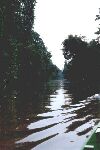 One of the best parts of the cruise was on the way back when the boatman cut the outboard motor and just paddled for some time, the difference was amazing, just the sounds of the Rainforest all around us. One of the best parts of the cruise was on the way back when the boatman cut the outboard motor and just paddled for some time, the difference was amazing, just the sounds of the Rainforest all around us.
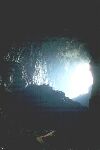 Next day we again returned by bus to Sandakan and caught a short flight back over to Kota Kinabalu where that night we had a final dinner with our group which would split up on the following day. We caught a taxi to our nice hotel where we were due to stay for the remaining seven days of our holiday. Next day we again returned by bus to Sandakan and caught a short flight back over to Kota Kinabalu where that night we had a final dinner with our group which would split up on the following day. We caught a taxi to our nice hotel where we were due to stay for the remaining seven days of our holiday.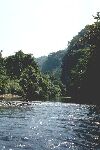  However we knew we would miss something special that we hadn't booked as part of our trip unless we organised it while we were here. That was a trip to the other Malaysian state in Borneo; Sarawak and the famous Mulu National Park. We booked the return flights locally, ordered a taxi and a day after settling in to our plush hotel we were off again for more adventure. However we knew we would miss something special that we hadn't booked as part of our trip unless we organised it while we were here. That was a trip to the other Malaysian state in Borneo; Sarawak and the famous Mulu National Park. We booked the return flights locally, ordered a taxi and a day after settling in to our plush hotel we were off again for more adventure.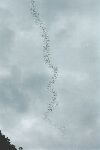 After two short flights, first from Kota Kinabalu in Sabah to Miri in Sarawak and from there to Mulu airport and on to the park where we met our guide for the two days whose name was Churchill. Unusually large and stocky for a Malay, Churchill was full of knowledge about the park, the wildlife and of course, the magnificent caves. After two short flights, first from Kota Kinabalu in Sabah to Miri in Sarawak and from there to Mulu airport and on to the park where we met our guide for the two days whose name was Churchill. Unusually large and stocky for a Malay, Churchill was full of knowledge about the park, the wildlife and of course, the magnificent caves. 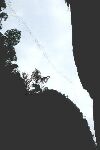 We visited four caves, each different. We visited four caves, each different. 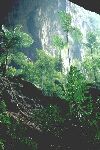 Lang cave is an amazing show cave, Deer cave is massive and home to 2 - 3 million bats who stream out of the cave at dusk in an almost never-ending smoke-like ribbon. Clearwater cave was reached by boat and has a river running through it and Wind cave had the impressive King's Chamber with huge stalactites. While in Mulu we also visited a Penan tribal market where we bought some hand-made souvenirs. Lang cave is an amazing show cave, Deer cave is massive and home to 2 - 3 million bats who stream out of the cave at dusk in an almost never-ending smoke-like ribbon. Clearwater cave was reached by boat and has a river running through it and Wind cave had the impressive King's Chamber with huge stalactites. While in Mulu we also visited a Penan tribal market where we bought some hand-made souvenirs.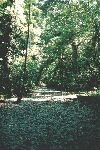
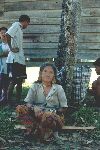 Flying from and back to Miri we realised just how different Sarawak is to Sabah. Sarawak is real rainforest country and the impression you get from flying over it is of passing over an enormous field of broccoli, all even yet multi-colours of green. Illegal forest burning was also evident especially from the plane. Flying from and back to Miri we realised just how different Sarawak is to Sabah. Sarawak is real rainforest country and the impression you get from flying over it is of passing over an enormous field of broccoli, all even yet multi-colours of green. Illegal forest burning was also evident especially from the plane.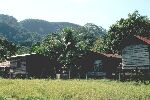 After a short ramble around Miri town it was back to Kota Kinabalu and some lazing around at the hotel. After a short ramble around Miri town it was back to Kota Kinabalu and some lazing around at the hotel. 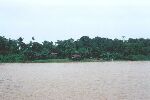
The Rasa-Ria hotel actually has it's own 60 acre forest within the grounds and they also have a small population of Orang Utans who we visited and got a much more intimate encounter than that at Sepilok.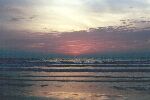
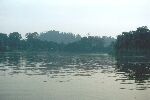
The amount that I've written about this holiday compared to previous years' indicates that this was not only the longest holiday but probably the best one yet. We were with a nice group of people, had a good guide, everything was arranged successfully and even the rigours of the Mount Kinabalu climb left us with nothing but satisfaction at having chosen Borneo as our honeymoon destination. Where to next??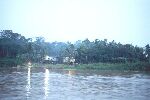
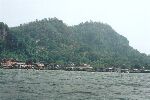
|